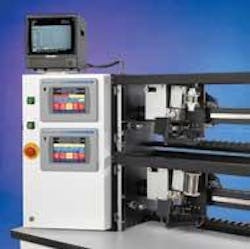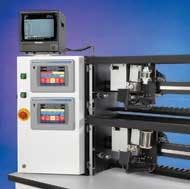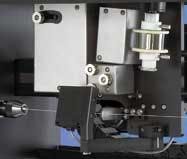Vision system automates catheter manufacture
Controlling the pitch and stiffness of medical coil windings allows custom catheters to be manufactured with precision.
By Andrew Wilson, Editor
Balloon angioplasty, an intravascular medical procedure, is frequently used to open blocked heart arteries, relieve symptoms of coronary artery disease, and improve blood flow to the heart. A catheter with an inflatable balloon at the tip is passed into a blocked heart artery. Once inserted, the balloon is inflated. Then, the catheter with the balloon is removed. Engineering By Design (EBD), which designs automated manufacturing systems, has developed a process for automating the manufacture of such catheters.
These balloon catheters also can be used to deliver a small metal coil or stent placed in the narrowed artery to improve blood flow. The stent permanently holds the artery open and reduces the rate of artery renarrowing. In addition, the coils also are used in aneurysm repair. Forcing the small coils into the vessel bulge area, the body reacts to it and seals the bulge through scarring.
In the design of the stents, thin wire is wound onto a spinning mandrel as small as 0.001 in. The wire can be anything from stainless steel to platinum or Nitinol (nickel titanium naval ordnance laboratory). Nitinol, a material that contains a nearly equal mixture of nickel and titanium, is used for its shape-memory properties. Because the length of the coils can exceed 5 ft and the diameter of the coil wire can be as small as 0.0004 in., controlling the winding of such devices must be accomplished automatically using precision coil-winding equipment.
PRECISION WINDING
Precise control of process variables is vital, and, in the design of the coil-winding machine, parameters such as the tension of the mandrel, the filament tension, and the control of the wind angle must be precisely maintained. To perform the winding operation, metal or plastic mandrels as long as 6 ft are held between two chucks at either end of a gantry (see Fig. 1). Maintaining the tension of the catheter cores is of primary importance during the winding process. To do this, a load cell interfaced to an Allen-Bradley PLC is positioned to measure the tension of the unwound catheter at one end of the gantry. Linear slides from Tolomatic under control of a servomotor are integrated with the PLC to maintain tension of the catheter to within 1 gram using feedback from a Transducer Techniques load cell.
After the catheter core mandrel is manually loaded on the machine, a transverse coil-winding mechanism isFigure 1. To automate the process of catheter manufacture, Engineering By Design has developed an automated coil-winding machine that can wrap various wires made from platinum to Nitinol with diameters as small as 0.0004 in. onto metal or plastic up to 6 ft long.positioned on a rail above one end. This mechanism consists of a spool of wire that wraps around a dancer arm and three small pulleys. To control the filament tension to within 0.1 g, a load cell integrated into the secondary pulley reads the filament tension and provides feedback to the PLC. This feedback is then used to control the torque of the dancer arm to maintain a constant filament tension. The spool’s motor is driven to maintain the dancer in a central position, as detected by an integrated optical encoder (see Fig. 2).
After the wire is attached to the catheter through the filament dispense mechanism, the chuck spindles are rotated at up to 6000 rpm drawing the wire onto the mandrel. Mounted on a linear drive, also under control of the system’s PLC, the traverse mechanism is then moved across the mandrel as the wire is drawn into the coil shape. “In the production of catheters,” says EBD president Dale Henson, “it is sometimes necessary to vary the stiffness of the finished wound catheter at different points. For example, the finished catheter may need to be soft and flexible at the distal end, yet remain stiff and rigid at the proximal end.”
PITCHING THE WIRE
The pitch of the wound coil must be adjusted during the winding process. “To control the stiffness of the finished coil,” says Henson, “the angle between the output of the filament dispense mechanism and the mandrel must be closely controlled. If, for example, a tight, rigid coil needs to be produced, a back angle will be used. For soft, flexible catheters, this wind angle may be from perpendicular to as high as 30° ahead of the wind point.”
To monitor this angle, Henson and his colleagues used an IVS-32 machine-vision sensor from Sharp Manufacturing Systems. This integrated machine-vision system consists of one or two cameras for capturing images and a controller for processing images and generating output signals. “Because the system does not require a PC,” says Henson, “it can be directly interfaced to PLC-based systems and programmed using the systems “set wizard,” a software support function that assists in setting the measurement conditions for the image sensor camera.
By selecting measurement items on images displayed on a standard video monitor, simple machine vision measurements can be made very rapidly. And since each of the steps in the setting wizard is displayed in a list on an operation chart, previously set steps can be recalled immediately should any changes need to be made. “The IVS system can store up to 32 programs, each using up to four measurement tools. Inspection programs can be set up from the system’s keypad or selected through the parallel I/O or serial port interfaces,” he says.
ADDING IMAGING
To ensure proper image integrity, the wire is illuminated as it emergesFigure 2. To control the filament tension to within 0.1 g, a load cell integrated into a pulley reads the filament tension and provides feedback to the PLC. A tension mechanism controls the torque on the dancer arm to maintain a constant filament tension from the spool's drive motor.from the filament-dispensing mechanism by a red LED area array. The images of the wire shadow are then captured by the system’s 1/3-in. CCD camera and digitized by the IVS-32. “By properly mounting the lighting and the camera on the mechanism, the x-y position of the wire in relationship to the mandrel can be visualized (see Fig. 3). To measure this angle, the system is preprogrammed to detect a number of x-y reference points. After the x-y reference points are compared with the x-y position of the points in the captured image, x-ydata are serially transferred to the host PLC where the angle between the output of the coil winding mechanism and the mandrel is computed using simple geometry.
After this angle is computed, the pitch of the angle can be changed by changing the gearing ratio between the chucks that spin the catheter and the linear transverse servo motor. By changing the speed of the coil winding mechanism with respect to the chucks, the pitch of the wrapped wire and thus is stiffness can be variably controlled throughout the manufacturing process.
To provide a simple user interface for the coil-winding machine, Henson and his colleagues deployed a PanelView Plus operator terminal from Allen-Bradley. “Programmed with Allen-Bradley’s RSView Studio Machine Edition, the panel is ideal for applications that need to monitor, control, and display information from digital I/O, RS-232, Ethernet-based, and PLC-based systems such as our coil-winding system,” he says.
By improving the accuracy of the control parameters, the Engineering By Design catheter coil-winding machine can increase productivity through reduced rejects and faster wind speeds. And, because the programming of the machine is flexible, new products can be manufactured using the same machine. With the availability of this technology, product designers can design and build more-reliable products.
Indeed, Henson foresees the system being used in other applications apart from catheter design. “These systems also could be used to increase the reliability, precision, and speed of the manufacture of brushless-servomotor manufacturing or medical microcoils,” he says.
To automate the process of catheter manufacture, various medical companies, including Boston Scientific, Medsource, Medtronic, and Conceptus, called on Engineering By Design (EBD). A developer of automated manufacturing systems for the medical, semiconductor, and nuclear-power industries, the company designs low-volume, high-end specialty products.
“Because of the size of the components used in manufacturing intravascular devices,” says Dale Henson, president of EBD, “the precise control of process variables is very important.” Programmable wind tensions of less than 1 gram and wind angle accuracies of less than 1/10 degree require the use of high-performance control systems and machine-vision systems that measure the wind angle without touching the filament. Statistical data for each run must be captured so that it is possible to both verify the product quality and use the information to refine the manufacturing process.”
features, advantages, benefits
To automate the process of catheter manufacture, various medical companies,
"Because of the size of the components used in manufacturing intravascular devices," says Dale Henson, president of EBD, "the precise control of process variables is very important." Programmable wind tensions of less than 1 gram and wind angle accuracies of less than 1/10 degree require the use of high-performance control systems and machine-vision systems that measure the wind angle without touching the filament. Statistical data for each run must be captured so that it is possible to both verify the product quality and use the information to refine the manufacturing process."
Allen-Bradley, Milwaukee, WI, USAwww.ab.com
Boston Scientific Natick, MA, USA
www.bostonscientific.com
Conceptus, San Carlos, CA, USAwww.conceptus.com
Engineering By Design, San Jose, CA, USA
www.ebdesign.com
MedSource Technologies, Minneapolis, MN, USA
www.medsource.com
Medtronic,Minneapolis, MN, USAwww.medtronic.com
Sharp Manufacturing Systems, Osaka, Japan
sharp-world.com
Tolomatic,Hamel, MN, USAwww. tolomatic.com
Transducer Techniques, Temecula, CA, USA
www.transducertechniques.com



